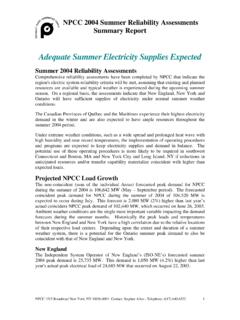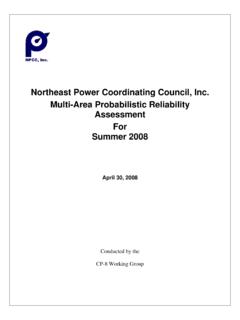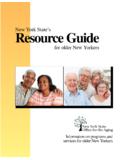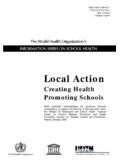Transcription of Spring 2018 Compliance and Standards Workshop …
1 Spring 2018 Compliance and Standards WorkshopMay 23 - 24, 2018 Criteria Services UpdateGerry DunbarManager, Reliability Criteria5/24/18 Criteria Services Program Area2018 Initiatives A-10 Classification of BPS Elements Strategic Review of NPCC Criteria Remedial Action Schemes (RAS)5/24/18 NPCC Criteria NPCC Full Members Develop and Own Criteria Who: NPCC Full Members Obligated to Comply Non-Members via Other Agreements (Tariff and Interconnection) What: Applies to the NPCC Bulk Power System (A-10 Methodology) Why: Section 313 NERC Rules of Procedure Promote Reliability Augment and Enhance ERO Standards11/09/2017A-10 BPS Classification Scope of Review: Identify critical facilities for the applicability of NPCC criteria Simplify the existing methodology to make it less labor intensive Improve consistency across areas in application and outcomes Phase #1 2017: Review Existing Methodology Propose Improvements Propose New Methodologies Recommendation to the RCC for Testing.
2 5/24/18A-10 BPS Classification Phase #2 2018: Testing of 3 RCC Approved Methodologies. First Iteration of Test Results to the Task Forces June 2018. RCC Endorsement of a Preferred Methodology December 2018 Anticipated 2019 Activity: Revise A-10 Document Open Process Postings Full Member Ballot5/24/18 Strategic Review of NPCC Criteria Strategic Review of the Need for NPCC More Stringent Criteria. Directed by the NPCC Board of Directors. Arranged by Focus Area Operations Planning Protection High Level Not Directory Specific or Requirement by Requirement. Action Plan and Scope Approved April 2018. Task Force Review August 2018. RCC and RSC Review and Comment September 2018. Final Report to RCC and RSC December Action Schemes (RAS) RAS Definition Approved by FERC 11/19/2015 Continent wide need to establish a uniform definition. NERC Glossary term for SPS revised ( See RAS ) PRC-012-2 (RAS ) Approved by FERC 9/20/2017 PRC-12-1, PRC 13-1, PRC-14-1 Withdrawn PRC-15-1 and PRC-16-1 Retired PRC-012-2 Limited Impact RAS Established (NPCC Type III) Regional Review Retained5/24/18 Remedial Action Schemes (RAS)NPCC Transition NPCC Transition to RAS: Existing NPCC RAS/SPS List: SPS that conform to Revised Definition of RAS SPS does not conform Newly Identified RAS Regional Review.
3 NPCC Glossary Term SPS See NERC RAS NPCC Directory #7 Appendix B Other NPCC Documents5/24/185/24/18 Questions or Comments ?NPCC Spring 2018 NAGF Update NAGF what, who and how Cold Weather Preparations Recent & Upcoming Activities2 Agenda3 What is the NAGF?The NAGF is an independent, member-driven, non-profit organization of generator owners and operators, focused on NERC and other grid reliability mission is to promote the safe, reliable operation of the generator segment of the bulk electric system through collaboration with grid operators and we doWe provide a unified voice for the generator segment to NERC and the Regional Entities. We do this through open source collaboration and information exchange among our members and with other industry s dual focus Compliance with existing Standards The here and the now Collaborative efforts Best Practice sharing Discussion boards, file cabinet, etc.
4 On Groupsite Shaping policy Helping paint the futurescape Ensuring the unique perspective of the generation segment is understood and accounted for. Improve first time success of new regulations6 Cold Weather Preparations Lots of attention in the wake of the Polar Vortex 14 Created a Working Group to assemble information Created a greatest Hits document NERC engaged NAGF to review and revise: Reliability Guideline for Generating Unit Winter Weather Readiness Current Weather Preparations Winter 2018 Improved Reliability and Resiliency Trending in the right direction8 Recent and Upcoming Activities Coordinated with UVIG to kickstart the IRPTF Initial meeting in Washington DC fall 17 s Frequency Response & Battery Storage Workshop , August 1-2, Washington DC FERC discussions: Changing resource mixoShifting from OER to market / policy FERC s CIP Audits9 FERC s CIP audits FERC completed 5 CIP audits in 2017.
5 Planning more 3 in 2018 Non-public audits Notification 120 days prior to coming onsite Regional Entities do not know ahead of time Measured Compliance with CIP Standards , then went beyond Potential Violations were handed over to the Regional Entity Addressed risk and overall cyber security generated ORIs Other Risks Identified-Ex: - interactive remote access dual homed machines Developed a 23 page report with 21 lessons learned10 FERC s CIP audits Highlights: ORIs Consider all generation assets, not just BES, when determining impact rating. (Control ) Identify & categorize cyber systems used to support generation ex gas yard feeding multiple plants Review physical key management to ensure the same rigor in policies and testing procedures used for electronic access is applied to physical keys Perform regular inspections of BCSs to ensure no unidentified Electronic Access Points (EAPs) exist Consider employing host-based malicious code prevention for all BCAs, in addition to network level s CIP audits12 Recent and Upcoming Activities Initial Peer Review August 2018 Modeled after NATF s process Teams of up to 18 volunteer SMEs from across the NAGF membership come to the host facility/entity Scope is controlled by the hosting entity Review of up to six technical areas oCompliance ProgramoProtection Systems and Maintenance ActivitiesoCyber and Physical SecurityoTrainingoOperations (including Cold Weather Preparedness, Normal, and Emergency Operations)oModeling and Model Verification13 Peer Review SchedulePrior to Peer ReviewAction1 Ye a r 60 DaysHost Company and potential review teams are identified.
6 Review Teams are trained on conduct of participants and Principals of Excellence for each Technical Area. The host company identifies technical areas to be covered. NDAs are signed by participating review team 45 DaysHost Company has the right of refusal of any participant at host company request. Host company identifies travel (airport), transportation, lodging, and other visitor information to their host location45 30 DaysEach Review Team conducts at least one conference call with Host Company to identify scope of Peer Review30 14 DaysPeer Review Team and Lead conduct readiness meeting with Host Company and Review Teams. Team may request preliminary information that is helpful in identifying scope of Review Day 1 Action10:00 AM 12:00 PMParticipants arrive to host city/location12:00 1:00 PMHost provided lunch (NAGF does ask the host company to provide onsite lunches for participants). Introductions during lunch.
7 1:00 5:00 PM Conduct Reviews with SMEs from host company6:00 8:00 PMOptional Break the Ice Dinner for Participants hosted by host company14 Peer Review SchedulePeer Review Day 2 Action8:00 AM 12:00 PMConduct Reviews with SMEs with host company12-00 1:00 PMHost provided lunch1:00 3:00 Final Reviews with SMEs with host company3:00 4:30 PMReview Teams develop exit presentation4:30 6:00 PMDry Run Exit PresentationPeer Review Day 3 Action8:00 9:00 AMOptional Breakfast by Host Comments by Peer Lead and Host Company Lead09:00 10:00 AMExit Presentation by Peer Review Lead and Review Team Leads 10:00 11:00 AMQuestions by the host company11:00 11:15 AMFinal Comments by host companyAfter Peer ReviewAction0 30 DaysHost Company and NAGF will identify too sensitive information to share with members during a Lessons Learned program for NAGF30 60 DaysReview Team Leads will share experience and Best Practices with NAGF during a Lessons Learned Program6 MonthsHost company will be invited to share progress of implementation of recommendations, or share with the Forum why recommendations will not be and Upcoming Activities NAGF Annual Meeting & Compliance Conference Jim Robb providing Keynote Address ISO/RTO interface session Dual Track: O&P and CIP October 2-3 (4?)
8 In NERC s offices in Atlanta WebEx will be available16 NAGF Working Groups Security Practices / CIP Cold Weather Preparedness Standards Review Team Training Lessons Learned Peer Review Variable Resources Essential Reliability Services17 Collaboration: Groupsite18 NAGF members19A good presentation must always for Low Impact is due when??!20Q & ANortheast Power Coordinating Council, Inc. 2018 Spring Reliability ConferenceJames Merlo, PhDVP, Reliability Risk ManagementMay 24, 2018 RELIABILITY | ACCOUNTABILITY22017: Impacts Must be DelineatedWind Event vs. Water EventHurricane Ike - 2008 WindHurricane Harvey 2017 WaterRELIABILITY | ACCOUNTABILITY3 Two Category 5 Events to Analyze Hurricane Harvey s water flooded Houston and would not quit Hurricane Harvey s winds hit South Texas 85 substations damaged 225 transmission line outages Over 850 transmission line structures downed/damaged Over 6000 distribution poles downed/damaged Hurricane Irma was the largest impact storm to ever hit Florida A record million customers out of service for Florida Power & Light Previous record was million during Hurricane Wilma in 2005 Irma restoration took only 10 days versus 18 days during WilmaRELIABILITY | ACCOUNTABILITY4 Drones hastened restoration following both Harvey and Irma with unexpected versatility Mutual Assistance agreements provided essential equipment and material for both Harvey and Irma restorations Florida and its utilities shortened Irma
9 Restoration time with strong, prior investment in system hardeningEvent Analysis Key Findings & RecommendationsRELIABILITY | ACCOUNTABILITY5 Events Analysis Process Capturing Faint SignalsRELIABILITY | ACCOUNTABILITY6 Control Chart for the non-EMS Events (Per Month) Over TimeRELIABILITY | ACCOUNTABILITY7 Control Chart for the EMS Events (Per Month) Over TimeRELIABILITY | ACCOUNTABILITY8 Cause CodesRELIABILITY | ACCOUNTABILITY9 Continued Decline in Average Transmission Outage SeverityRELIABILITY | ACCOUNTABILITY10 Correct Protection System Operations RateRELIABILITY | ACCOUNTABILITY11 MisoperationRates Continuing to DeclineRELIABILITY | ACCOUNTABILITY12 MisoperationRates Continuing to DeclineRELIABILITY | ACCOUNTABILITY13200 kV+ Outages by Cause CodeRELIABILITY | ACCOUNTABILITY14 BPS Transmission Related Events Resulting in Load LossRELIABILITY | ACCOUNTABILITY15 BPS Transmission-Related Events Resulting in Load LossRELIABILITY | ACCOUNTABILITY16 Retirement/displacement of conventional generation Variable energy resources Rapid penetration of electronically-coupled resources Essential Reliability Services Reduced inertia Frequency Reponses Voltage Support Ramping and flexibility needs Rapid penetration of new loads System controls and protection
10 Coordination Modeling and simulation constraints Increasing interface with distribution-centric resourcesSystem Dynamic Character is ChangingRELIABILITY | ACCOUNTABILITY17 Primary & Secondary Frequency Control RELIABILITY | ACCOUNTABILITY18 Human ErrorRELIABILITY | ACCOUNTABILITY19 Duck CurveRELIABILITY | ACCOUNTABILITY20 The Need For Flexibility:A Future, Not a ScenarioLoad & Net Load (MW)01,0002,0003,0004,0005,0006,0007,000 8,0009,00014,00016,00018,00020,00022,000 24,00026,00028,00030,00032,00034,000 Load, Wind & Solar Profiles ---Base ScenarioJanuary 2020 Net_LoadLoadWindTotal SolarWind & Solar (MW)6,700 MW in 3-hours7,000 MW in 3-hours12,700 MW in 3-hoursNet Load = Load - Wind - SolarRELIABILITY | ACCOUNTABILITY21 Work as PlannedRELIABILITY | ACCOUNTABILITY22 Work as ExecutedRELIABILITY | ACCOUNTABILITY23 Human CapitalRELIABILITY | ACCOUNTABILITY24 All Trying to do the Right ThingRELIABILITY | ACCOUNTABILITY25 Sometimes it is a HumanRELIABILITY | ACCOUNTABILITY26 Your ArtifactsHelp Define YouRELIABILITY | ACCOUNTABILITY27 Risk versus ConsequencesRELIABILITY | ACCOUNTABILITY28 Blue Cut Fire Disturbance Event occurred on August 16, 2016 Not a qualified event Entities volunteered to work with ERO Fire caused 13 500 kV line faults and two 287 kV line faults NERC/WECC ad hoc task force created to identify causes Published disturbance report in June 2017 Key Findings: Use of momentary cessation Frequency-related tripping RELIABILITY | ACCOUNTABILITY29 Level 2 NERC Alert.
![Welcome [www.npcc.org]](/cache/preview/7/0/4/6/3/8/1/3/thumb-70463813e70cbd881cdccb4a4b4e1de9.jpg)












